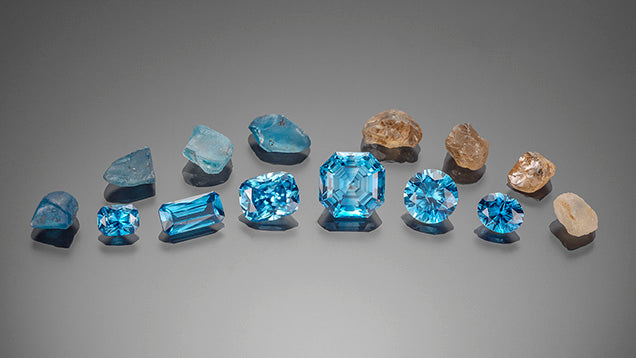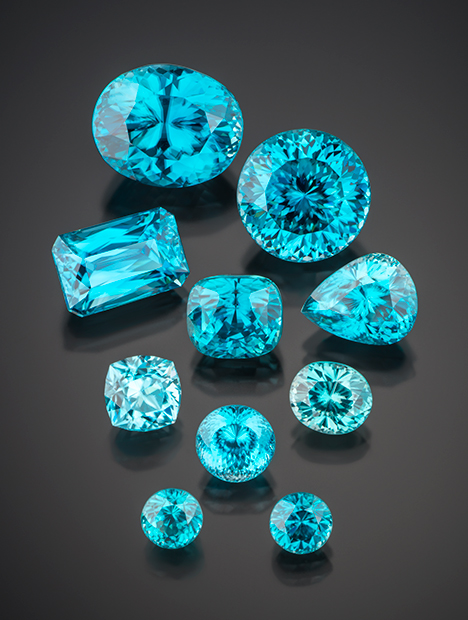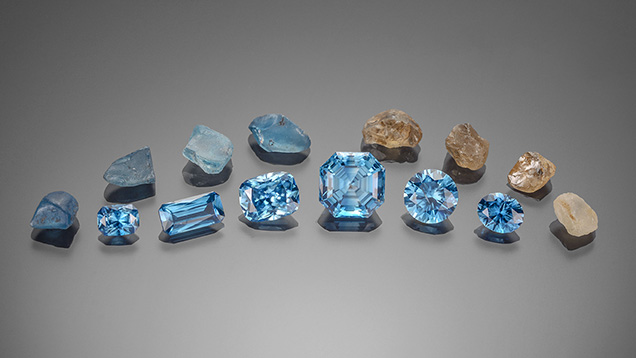
The Zing of Zircon, Part 7: The Story of Starlite
Share
One of the most valuable varieties of zircon, and certainly the most popular, is blue zircon. In some cases this zircon variety may be referred to as “starlite”, a trade name originally proposed by the American mineralogist and Vice President of Gemology at Tiffany & Co., George Fredrick Kunz, although this name was never universally adopted and is now used much less frequently than it once was; other trade names for blue zircon include “stremlite”, and the recently proposed name of “cambolite” meant specifically for blue zircon from Cambodia, the world’s largest source of this zircon variety. Despite the popularity and prevalence of blue zircon relative to other zircon varieties, very little blue zircon exists in nature; the overwhelming majority of blue zircon gemstones are unearthed as brownish crystals which are then subjected to heat treatment under reducing conditions in order to induce the beautiful blue hues for which they are known. Not all brown zircons will turn blue upon heating, it is only those zircon crystals which hold the right chemical features that will undergo this change when heated.
A collection of faceted blue zircon gemstones from Cambodia; Image: GIA/ Robert Weldon
The majority of blue zircon gemstones currently available in the jewellery marketplace, and nearly all Cambodian blue zircons, originate from the Ratanakiri Province of Cambodia in the northeastern portion of the country, a region where extensive gem mining takes place; aptly so, the name “ratanakiri” is derived from the Khmer words for “gem” and “mountain”, giving the possible english interpretations of either “mountain of gems” or “the place of gems and mountains”. Blue zircon gemstones have been popular since the Victorian era, but larger scale mining of zircon in Ratanakiri Province did not begin until the 1930’s, with some of the more productive deposits being located in the area of Ratanakiri Province’s capital, Ban Lung, and the nearby settlement of Bae Srak, as well as the area surrounding Bo Keo about 25 kilometres east of the capital. Multiple zircon mines in Ratanakiri Province produce brown zircons which turn blue upon heating, but the mines of Bae Srak specifically are associated with blue zircons of the richest colour, while stones from other Cambodian sources tend to exhibit lighter blue hues after treatment; no naturally blue crystals have ever been reported from the mining operations of Bae Srak.
A map of Cambodia showing Ratanakiri Province outlined in red; Image: Zeug et. al.
Geologically, Ratanakiri Province is part of the Indochina Cratonic Terrane formation, which stretches across southeast Asia and covers parts of Cambodia, Thailand, Myanmar, and Vietnam; due to similar geologic conditions in these countries, zircon deposits which produce brown stones amenable to the induction of blue colour by heat treatment have been found in multiple locations outside of Cambodia. Blue zircons have been successfully produced from brown stones of found in the Bang Kacha and Tok Prom areas of Thailand’s Chanthaburi Province, and the Bo Phloi area of Thailand’s Kanchanaburi Province, as well as from brown stones mined in the Central Highlands of Vietnam and Myanmar’s Shan State. In 2021, a new deposit of brown zircons was discovered near Maripa in the Chikwawa District of southern Malawi, with some of the stones from this find exhibiting a blue colour after heat treatment, although very little gem material has been produced from this deposit to date. Interestingly, some green metamict zircon gems from Sri Lanka may also turn light blue when subjected to heat treatment. Even though sources for blue zircon are found in numerous locations, Cambodia’s Ratanakiri Province remains the largest single source for this zircon variety.
A faceted blue zircon gemstone from Cambodia; Image: Skyjems
The treatment process for blue zircon involves heating stones for a few hours in the absence of oxygen to temperatures of approximately 900-1000°C, a heat level low enough to be achieved with charcoal fires; typically carbon monoxide and/or nitrogen gas are used to produce oxygenless conditions within the crucibles which hold stones during the course of treatment. In some cases, brown stones may turn colourless when heated. Curiously, the blue colour of treated zircon gemstones is not apparent immediately after ideal treatment temperatures are reached, and hot stones will initially show white or silvery tones; only after being allowed to cool do freshly treated zircon stones of the right chemistry reveal their attractive blue hues. What is also interesting about these treated stones is that some have been reported to temporarily change colour in response to light exposure, a phenomenon known as “tenebrescence”; exposure to long wave ultraviolet light can cause tenebrescent blue zircons to become brownish in colour for some time before eventually returning to their original blue hues. Blue zircon would be substantially less available for use in gemstone jewellery without the application of heat treatments, as blue is the rarest colour to occur naturally in this mineral without human intervention, followed by green and then red. There have been anecdotal reports from Vietnam, Cambodia, Myanmar, and Sri Lanka of untreated blue zircon crystals surfacing as part of raw material yields primarily composed of other zircon colours, however these accounts are so few in number that they are not regarded as particularly significant in the context of the gem trade, and never have these stones been discovered as part of a full “deposit” of blue zircon; the only place where a high enough concentration of untreated blue zircon has been found for the locality to be regarded as the site of a naturally blue zircon deposit is in Campania, Italy among the syenites which were once ejected by the volcanic activity of Mount Vesuvius.
Heated blue zircon crystals (left) and gemstones (centre) from Malawi, with crystals of their untreated source material (right); Image: Gemological Institute of America
© Yaĝé Enigmus








